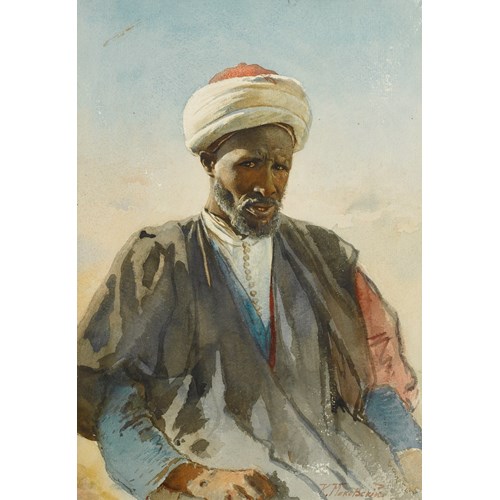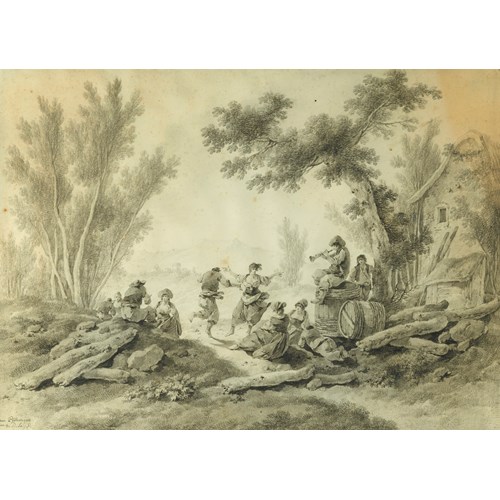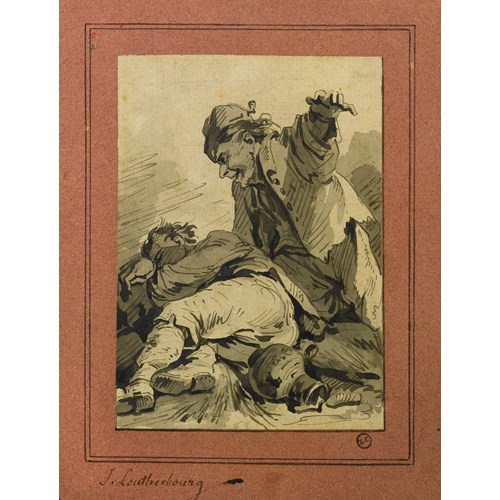Marketplace
Koktebel
Maksimilian Aleksandrovich Voloshin
Koktebel
Date 1928
Epoque 20th century
Origine Ukraine, Russia
Medium Pen, Watercdolour on paper, Laid on cardboard
Dimension 26.2 x 34 cm (10³/₈ x 13³/₈ inches)
‘Indented concentration of the rocks
Along with prairies and flickering expanses
Gave freedom to my verse and measure to my thought.
Since then are saturated with my dreams
Heroic reveries of drowsing foothills
And stone mane of wistful Koktebel’
- M. Voloshin, Koktebel, from the series Cimmerian Spring, 1918
With its tempered palette of neutral tones, and its pervading sense of mystical symbolism, Maksimilian Aleksandrovich Voloshin’s Koktebel draws parallels with the Russian symbolist artists Mikhail Nesterov (1862-1942), and Nicholas Roerich (1874-1947). A philosopher as well as a painter, Voloshin was a key exponent of the Russian Symbolist movement. The musical and rhythmical expression of the Symbolists’ written word, appears to have been translated here into the undulating and defined mountainous landscape, the prominent contours of which immediately identify the panorama as being Koktebel.
The small settlement of Koktebel in eastern Crimea, originally inhabited by Tatars, and known since the time of the ancient Greeks as Bosphorus Cimmerius, was populated in the early nineteenth century by Bulgarian refugees. For Voloshin, Koktebel, and its surrounding area, had a profound significance. It was here that the artist spent the summer months of his youth, between 1893 and 1897, intensively studying the geology, geography, ethnography, flora and fauna of the eastern shore of the Crimea and observing the contours and colours of this landscape, which would later inspire much of his poetry and many of his watercolours.
Having spent much of his childhood in Koktebel, Voloshin felt a deep bond with the land. In 1917 he was drawn back to the area and decided to settle there. Voloshin transformed the town into an artistic and literary colony of considerable importance. The likes of Marina Tsvetayeva (1892-1941), Osip Mandelshtam (1891-1938), and Andrey Bely (1880-1934), all guests at Voloshin’s home, later known as ‘The Poet’s House’, were inspired to write about this mystical landscape. Koktebel was Voloshin’s spiritual home, and when the locals pointed out that the silhouette of a bearded man, which could be made out on the nearby rocky headland of Kok-Kaya, resembled the artist, this further cemented Voloshin’s connection with the area. Referring to the promontory in his poem Koktebel, Voloshin wrote: ‘And on the cliff, enclosed by the ripples of the bay, wind and fate together have carved my profile...’ (Koktebel, 1918). After his death the promontory became known as ‘Voloshin’s profile’.
Along with prairies and flickering expanses
Gave freedom to my verse and measure to my thought.
Since then are saturated with my dreams
Heroic reveries of drowsing foothills
And stone mane of wistful Koktebel’
- M. Voloshin, Koktebel, from the series Cimmerian Spring, 1918
With its tempered palette of neutral tones, and its pervading sense of mystical symbolism, Maksimilian Aleksandrovich Voloshin’s Koktebel draws parallels with the Russian symbolist artists Mikhail Nesterov (1862-1942), and Nicholas Roerich (1874-1947). A philosopher as well as a painter, Voloshin was a key exponent of the Russian Symbolist movement. The musical and rhythmical expression of the Symbolists’ written word, appears to have been translated here into the undulating and defined mountainous landscape, the prominent contours of which immediately identify the panorama as being Koktebel.
The small settlement of Koktebel in eastern Crimea, originally inhabited by Tatars, and known since the time of the ancient Greeks as Bosphorus Cimmerius, was populated in the early nineteenth century by Bulgarian refugees. For Voloshin, Koktebel, and its surrounding area, had a profound significance. It was here that the artist spent the summer months of his youth, between 1893 and 1897, intensively studying the geology, geography, ethnography, flora and fauna of the eastern shore of the Crimea and observing the contours and colours of this landscape, which would later inspire much of his poetry and many of his watercolours.
Having spent much of his childhood in Koktebel, Voloshin felt a deep bond with the land. In 1917 he was drawn back to the area and decided to settle there. Voloshin transformed the town into an artistic and literary colony of considerable importance. The likes of Marina Tsvetayeva (1892-1941), Osip Mandelshtam (1891-1938), and Andrey Bely (1880-1934), all guests at Voloshin’s home, later known as ‘The Poet’s House’, were inspired to write about this mystical landscape. Koktebel was Voloshin’s spiritual home, and when the locals pointed out that the silhouette of a bearded man, which could be made out on the nearby rocky headland of Kok-Kaya, resembled the artist, this further cemented Voloshin’s connection with the area. Referring to the promontory in his poem Koktebel, Voloshin wrote: ‘And on the cliff, enclosed by the ripples of the bay, wind and fate together have carved my profile...’ (Koktebel, 1918). After his death the promontory became known as ‘Voloshin’s profile’.
Date: 1928
Epoque: 20th century
Origine: Ukraine, Russia
Medium: Pen, Watercdolour on paper, Laid on cardboard
Signature: Signed with monogram and dated '1928' (lower left), with a dedication in Cyrillic: 'Dear Boris Ivanovich in memory of Koktebel/ according to some maps here used to be a town and port/ Maximilian Voloshin' (lower left).
Dimension: 26.2 x 34 cm (10³/₈ x 13³/₈ inches)
Plus d'œuvres d'art de la Galerie









